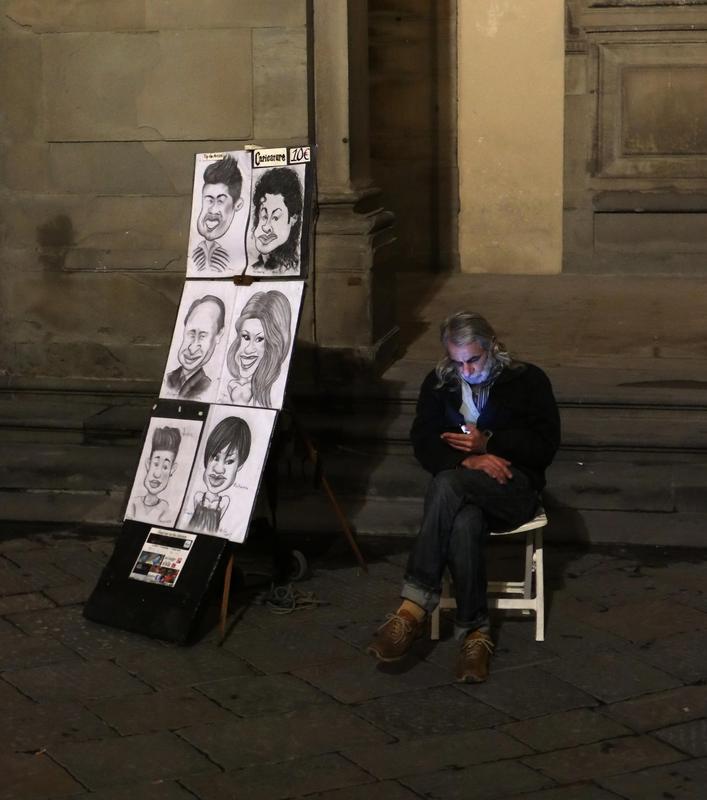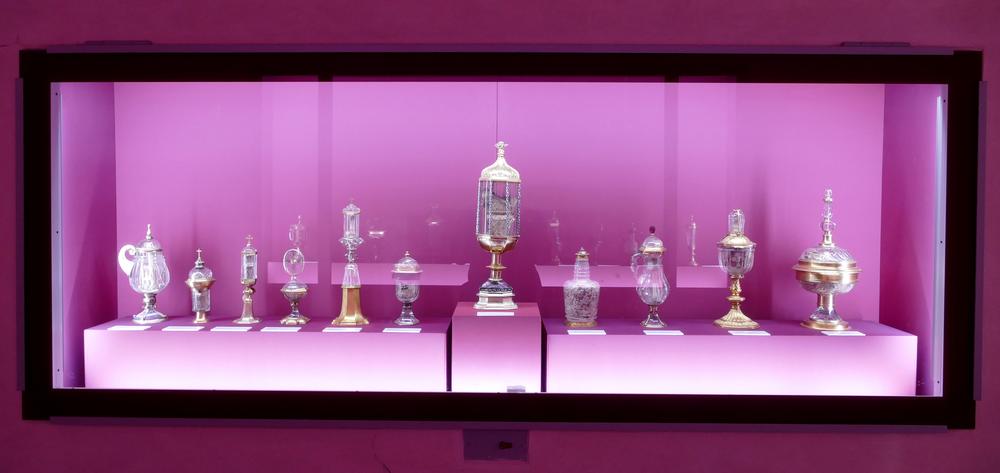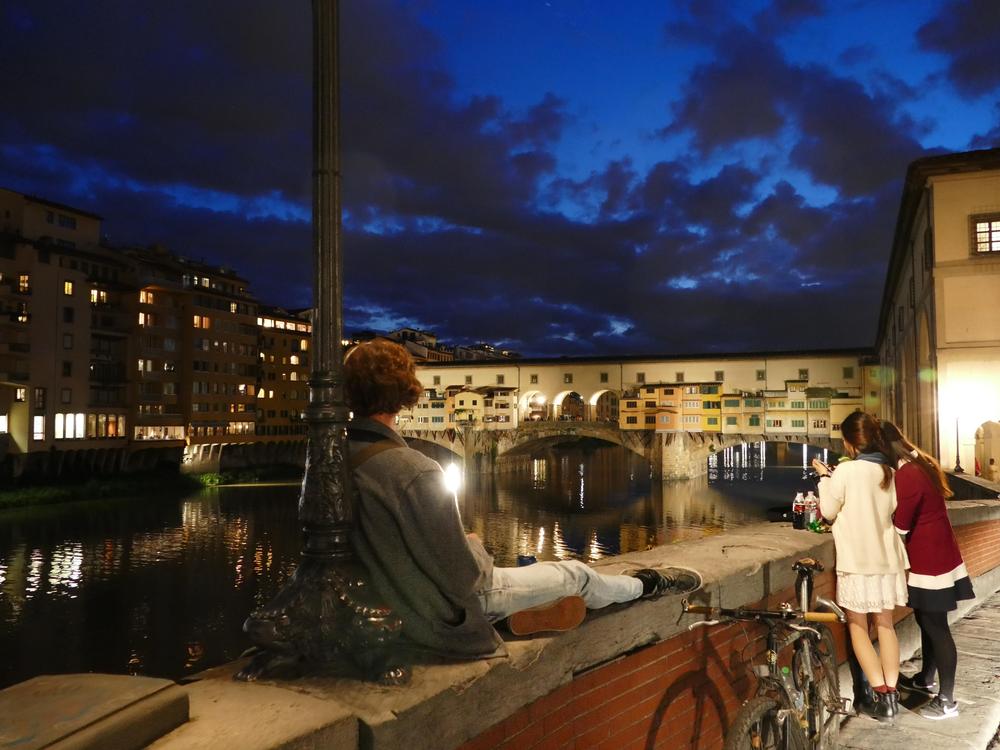photo: waiting for business in one of Firenze's main squares

Got up late this morning, spent a fair chunk of time after breakfast arranging a couple places that needed to be booked in advance: the Accademia and the Capella Brancacci inside Santa Maria del Carmine (with thanks to my B&B hostess who made the phone call for that one). That's the Brancacci Chapel, which has a rather well known fresco by Masaccio, including the Expulsion of Adam and Eve from the Garden of Eden. I'm guessing you'll recognize it: https://en.wikipedia.org/wiki/Expulsion_from_the_Garden_of_Eden .
I wanted to go to Museo Nazionale Alinari Fotografia (which I found in the Rough Guide). I also wanted to go to the brand new Museo Novecento, which I found in Lonely Planet. Except ... it registered this morning that they're both at the same address: and neither guide mentions the other museum. I correctly guessed that the perpetually out-of-date Rough Guide was in the wrong: the Photographic Museum died (and didn't get sent anywhere else, so I can't see it at all) about two years ago, and in its place we have a new museum of recent Italian Art. I love almost everything about the Rough Guides, and I dislike many things about Lonely Planet: but being up-to-date counts for a lot in the travel guide business. On most trips with a Rough Guide, I'll find about two restaurants a week that have ceased to exist: rarely a problem with Lonely Planet. It's very frustrating.
Museo Novecento: I'm a big fan of "modern" art, which means - approximately - anything from about 1850 forward. But like any art, it's a crap shoot whether or not you're going to like what you see. Novecento is a mid-sized gallery with purely Italian stuff from all through my time range, but I'm afraid that it was a bust for me - only a few pieces I kind of liked, and nothing I loved.
Across the street is the very large Santa Maria Novella church complex: a church, a bunch of buildings that were once a Dominican monastery(?), three cloisters(!), a museum, and catacombs. The first thing I noticed on the way in was that the green and white marble facade on the front of the church was precisely that: one layer of marble facing the square, and the entire rest of the building behind it is rough brown stone. Inside is another very large, fairly empty church, with Giotto's famous crucifix (a large cross-shaped painting rather than a sculpture) suspended in the nave. While preparing this and reading up in the guide book, I find that I casually ignored what are considered some of the greatest works of Masaccio, Filippino (not Filippo) Lippi, and Domenico Ghirlandaio as I toured the church: apparently they didn't strike me as particularly noteworthy. Oops. And surprisingly, even the two cloisters we could get into seemed somewhat ratty to me - the trees were dying. The third cloister, the "Great Cloister," was visible but closed to us.
The city was threatened with some percentage of rain yesterday, but it never materialized. The weather report suggested much the same percentages today, but the rain showed up around 1400 - light, but accompanied by some impressive thunder. I was happily still in Santa Maria Novella, and enjoyed sitting in one of the cloisters watching the rain fall.
My next destination (this probably sounds all carefully planned to you, when in truth half of it is me going "oh, that's open and I'm here") was the Capella Medicee. The Medici ruled this city for several generations, and they were exceedingly rich. They don't seem like they were particularly nice people, but they were huge patrons of the arts. The chapel entrance includes a metal detector, the first time I've seen one of those. When I emptied my pockets, they politely snagged my Swiss Army knife and gave me a number to pick it up on the way out.
The first part of the Medici chapel is an incredibly dour place, done - rather spectacularly, I admit - in several shades of very dark marble, and with massive, over-wrought sarcophagi embedded in the walls over our heads. It was extremely ostentatious, but also a lot of fun to look at. But it's also not the reason that most people walk through the doors: that comes in the next room, the tombs of ... ah, I don't remember their names. It doesn't matter - they weren't the important Medicis. What matters was that two of the tombs were entirely sculpted by Michelangelo, and he had a hand in the third as well.
I had a Michelangelo epiphany in Rome: I hadn't quite "got" his Moses from the photos I'd seen. But in the presence of that sculpture ... wow, it's brilliant and even a little scary. He's a really big guy, and he looks like he's about to rocket out of that chair. ( https://en.wikipedia.org/wiki/Moses_%28Michelangelo%29 ) I mention this because ... I didn't get that effect with these sculptures. Moses had left me believing anything is possible with Michaelangelo, but it didn't happen here. There's still "the David."
I think I want to go back to Rome - to see Moses and the St. Peter Pieta again, and to see the Bernini Museum.
The last stop of the day before dinner was San Lorenzo. The ticket office leads you to the museum under the church first, and there I was reminded that the Florentines seem to have a particular fascination with reliquaries and relics. Like, bits of dead saints. It's kind of gross: they make these incredibly ornate gold and silver and glass boxes and cylinders and chalices to hold pieces of bone, clumps of hair, and various other unidentifiable bits. The times you come across fingers - complete with shrivelled skin - makes you wish they'd stuck with "unidentifiable." San Lorenzo has something like 15 or 20 of these on display, and most of the churches I've seen here have several of their own - although this collection was the largest so far. They also have a really lovely cloister with an orange tree in full fruit in the middle.
photo: Reliquaries in the Capelle Medici

And at last up the stairs to the church. I'm afraid I've chosen my visit to Florence as the time to burn out on Medieval religious art: not exactly optimal. San Lorenzo is full of epically large paintings in bays along the walls, and a couple were fairly striking, but none really sparked my enthusiasm.
I then visited Carabé Gelateria, where I got the Rough-Guide-recommended cannoli. Let me start by saying, it's going to be a LONG time before I eat that stuff Toronto Italian bakeries use that name for. So incredibly good.
On the way back to my B&B for a short break I stopped in at the Mercato Centrale cafeteria/food market. There's a full scale food market much along the lines of Toronto's St. Lawrence Market downstairs, but it's closed by 1400 or so - certainly before I arrived. But the shops selling prepared food and wine upstairs remain open well into the evening with a large and talkative crowd. Cool place: I hope to go back and sample later.
After a break at the B&B, I made my way to a Lonely-Planet-recommended restaurant, Trattoria Marione. I ordered the pasta with butter, parmesan, and black pepper, with a side of "peas and ham" and a glass of the house Chianti (the regional wine). This was a fairly mixed blessing: a plate arrived on my table with thick noodles in white sauce, but no cheese or black pepper. And I couldn't get a server's attention for the life of me. Somehow parmesan magically appeared on my table, but I eventually borrowed the black pepper from the people next to me. Then the side showed up, and they'd used canned peas - ugh, couldn't you at least use frozen, which tastes approximately like the real thing? The noodles were incredibly thick (4mm?) and chewy, and once topped with cheese and pepper, were really excellent. And the tiramisu I had for dessert was possibly the best I've ever had, even eating it four or five nights straight in Rome. The service, however, was a bit shaky.
A walk around town in the evening produced what I hope will be some good photos: the caricature artist you see above waiting for business, and the Ponte Vecchio at night below were both from this stroll.
photo: the Ponte Vecchio bridge
